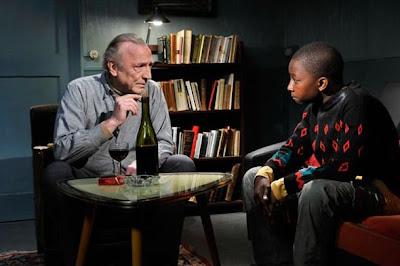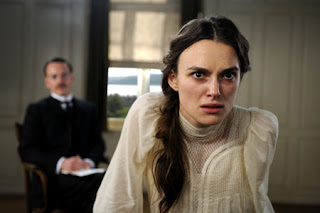A group of friends and I saw Midnight's Children in its New England premiere as part of the Telluride at Dartmouth program at Dartmouth College. (I saw a bunch of the films last year, but don't have time this year and, in any case, am not as enthusiastic about the selection as I was last year.)
The group of us had very different reactions to the movie, with some people extremely enthusiastic about it. For me, it was unfulfilling, and seems a perfect illustration of two general rules: 1.) novelists should not adapt their own books for the screen; 2.) Great books don't make great movies.
A surprising amount of the plot of Salman Rushdie's original novel is retained in the film, and this seemed to me the heart of its problem. A novel of 500+ pages has the room to let its incidents spread out and breathe; a 148-minute film can only include the majority of those incidents if it spends very little time on any of them. And that's what happens. The movie zips along, but it's in such a hurry that nothing much feels like it matters. A story like Midnight's Children, which takes place over many decades and various locations, is especially unsuited to such crammed rushing. It flattens characterizations, making everyone seem like a caricature, and accentuates the many coincidences and contrivances that feel less ridiculous in a large novel. The effect is to make the world of the movie feel absurdly small, and, by the end, to leave it no recourse other than a thin sentimentality. The film sacrifices everything to get as much of the book's plot in as possible, and thus ends up less like an adaptation of the novel than of its SparkNotes summary.
One of my pet peeves with adaptations of complex works of literature is that they rarely seek to find a cinematic equivalent to the literary style. Midnight's Children is interesting as much for its language and structure as for its events, but neither Rushdie in his linear and unimaginative screenplay or Deepa Mehta in her direction find any sort of analogue for that. Rushdie himself gives an ever-present narration in voiceover, further making the film seem like an illustration of the book — we get to look at pictures while somebody reads at us! Last year, I had mixed feelings about We Need to Talk About Kevin, but one of the things I most admired was its determination to be a movie unto itself and not merely an illustration of the novel. The book exists as a work of art in its own right; the movie should, too.
I was often annoyed by the film's colors, which are frequently saturated and sometimes desaturated — manipulation that renders all the whites glowing, blank, and depthless, giving the whole movie an unreal quality that was certainly intentional but to my eyes screamed of kitsch. The same is true for some digital effects in the last third or so of the film, where it sometimes looks like lost outtakes from 300. Occasionally, such as scenes in a Delhi slum, the saturation of colors provides beautiful greens, reds, blues, and yellows, but on the whole the effect was distracting, and especially disappointing given that I thought Mehta's earlier film, Water, was visually powerful and affecting.





I'm two things right now:
1) Jealous that you got to see this before me. You bastard.
2) Rather annoyed that they made it a film and not a TV series. I thought they wanted it to be a 10-episode miniseries or something?
Meh. I hope the same thing doesn't happen to Cloud Atlas. I really want to see that...
This makes four of my favorite books coming out as movies this year. I admit, the trailer above does not make me want to see this movie. Not having seen it, I do agree with your remarks. Great books rarely make great movies. Authors should not adapt their own work. Movies must leave things out, the simply must, if they're going to say anything worthwhile about what they leave in.
I'm still going to go ahead and see Cloud Atlas, Life of Pi and Wuthering Heights. But, probably not this one.
Well, my take may be unduly negative. Some of the folks who went with me really enjoyed the film, including some who had read the book. I could just be Grumbly McGrumblypants. (Or maybe they were enjoying remembering the book as much as anything.) I definitely wish they'd had 10 hours for a min-series, though I think if Deepa Mehta had been the director I still would have been disappointed, because some of the aesthetic choices really irritated me.
I've got my hopes up for Cloud Atlas, but I'm trying not to get those hopes too high, because it's such a difficult adaptation to pull off. Maybe if I go in expecting to hate it, I'll be okay...
thanks this
This comment has been removed by a blog administrator.